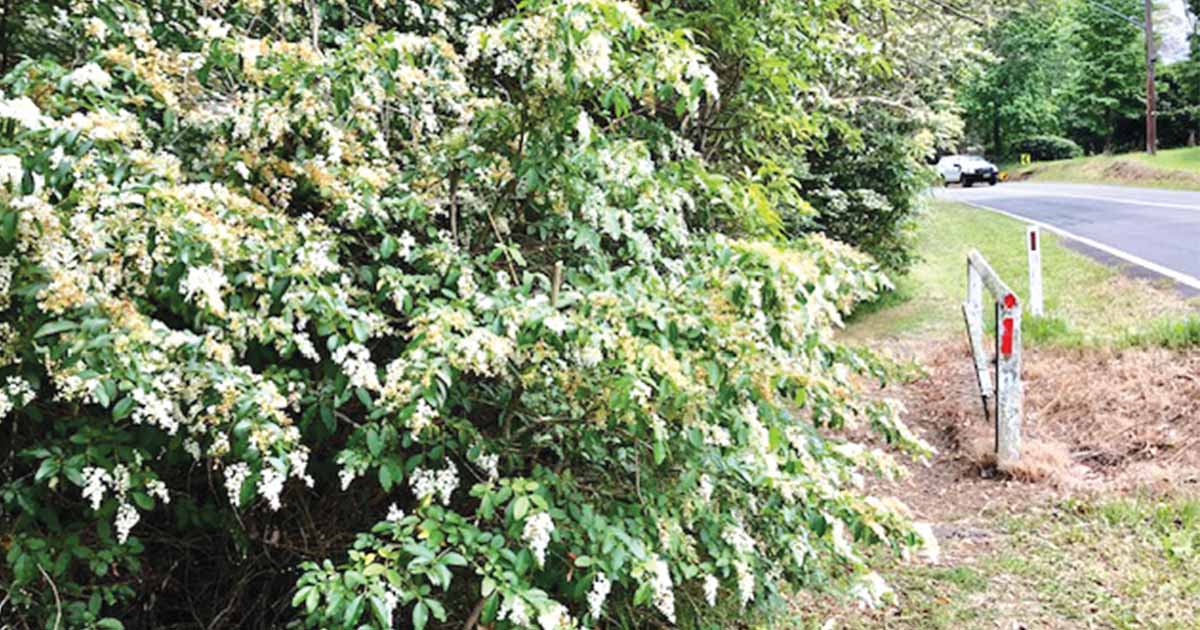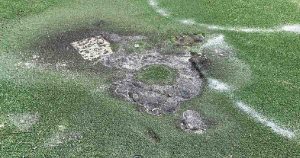
By Karlene Brummer
Each year as I travel around our beautiful suburbs I take particular interest in noticing what types of vegetation are exhibiting the best ‘show’. This year I observed that Photinia and Azaleas were flourishing particularly well, but to my dismay so was PRIVET. I don’t think I have ever seen as much Privet flowering with such force since I moved here in 2010. Obviously conditions have been just right for this pesky plant to not only spread exponentially, but to positively thrive!
The problem with privet is multifaceted. It is oftentimes used as a hedge or windbreak which is fine – but it must be trimmed before flowering to stop the spread of seeds by either water, bats or birds (particularly Currawongs).
Two types of Privet are prevalent in our location:
1. Smallleaf Privet (Ligustrum sinense)
2. Broadleaf Privet (Ligustrum lucidum)
The following information is reproduced from the Sydney Regional Privet Management Plan and the full pdf may be found by going to: https://sydneyweeds.org.au if you wish to learn more about this invasive species and how to mitigate it’s spread.
Both species of Privet are widespread in bushland gullies and creek lines throughout the Hornsby Shire, extensively in the urban bushland areas. Generally Ligustrum sinense is more prevalent in the urban areas and Ligustrum lucidum in the rural areas (on both private and Council managed lands). In residential areas, privet is often found in well established, abandoned or poorly maintained gardens, more frequently in areas with fertile soils.
In the Sydney region, Privet is one of the worst environmental weeds in bushland areas. It poses a significant ecological threat through its progressive and permanent domination of indigenous vegetation, especially in disturbed areas and the more fertile soils of gullies, creeklines and rainforest edges where moisture and nutrient levels are often elevated due to stormwater pollution and sewage overflows.
In higher rainfall areas with shale soils it is also known to infest relatively undisturbed bushland. Threatened species and endangered ecological communities are also at threat from Privet invasions. For example, Privet is threatening Persoonia mollis habitat and the Blue Gum High Forest in the Sydney North region. Privet propagates easily from seed where suitable conditions exist. Small-leaved Privet seedlings can form a dense carpet of over 600 per square metre after a site is initially cleared (Buchanan, R. 1989).
The young plants grow aggressively, have no natural enemies and are capable of displacing most native understorey species, forming dense thickets and competing heavily with native plants for light, water and nutrients – casting heavy shade under which little else can grow. An indirect impact of Privet and other fruit bearing exotic trees is that they support artificially high currawong populations, thus affecting other native bird populations.
Privet pollen and perfume is also recorded as having significant human health impacts, being highly allergenic and a major contributor to asthma, allergic rhinitis and hayfever. Councils receive numerous complaints every year from residents reporting individual flowering specimens which they feel are exacerbating their condition.
However, it has also been reported that these allergic reactions are actually related to the strong, sickly perfume of the flowers rather than the pollen. The leaves and fruit are also poisonous and dangerous to children. If Privet is kept pruned as a hedge with all flowers removed before full development, and thus eliminating the seed source, it does not pose a great environmental or human health risk. However with unchecked growth it will flower and fruit prolifically and spread to other areas.

Privet readily reproduces by seed, suckers from damaged stems and roots, and regrows from cut stumps. Each shrub can produce more than 10 000 seeds a year, with seed viability up to 98%. The seeds are spread widely by water, fruit-eating birds such as currawongs, bats, and dumped garden Sydney Regional Privet Management Plan – 2005/2010 10 waste. Exacerbating this, ripe Privet seedheads are regularly sold at the Sydney Markets to florists for floral arrangements, and Privet seedlings are commonly found for sale at various retail outlets and market stalls. Often this can be as various cultivars but these are prone to revert to the wild type, and most seedlings produced are similar to the wild type.
Species Management
Small Privet plants and seedlings can be manually removed, digging up as much of the main root system as possible to discourage suckering. Over large areas, seedlings can be sprayed using a Glyposate-based herbicide. Large specimens can be controlled using either the cut and paint, or frilling methods using an undiluted Glyphosate-based product.
In bushland areas, Privet should only be controlled where follow-up maintenance and replacement native regeneration/planting can be undertaken, whether by agency staff, contractors or volunteers. Special care needs to be taken along creeklines and in areas at high risk of erosion, where control works should be undertaken with a catchment management focus and possibly with the selective use of the frilling method only.
It is commonly recommended that Privet on private property be replaced with another non-invasive species – some native tree alternatives include Blueberry Ash (Elaeocarpus reticulatus), Lilly Pilly (Acmena smithii), Water Gum (Tristaniopsis laurina) or Cheese Tree (Glochidion ferdinandi). For hedging, Lilly Pilly (Acmena smithii), Syzigium sp and Photinia (Photinia glabra) are good alternatives.






